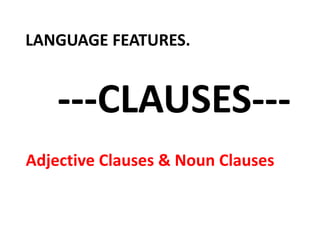
ADJECTIVE CLAUSES
- 1. LANGUAGE FEATURES. ---CLAUSES--- Adjective Clauses & Noun Clauses
- 2. A. Introduction; Adjective Clauses Clause : A clause is a group of words containing a subject and a verb. Independent clause : a complete sentence. It contains the main subject and verb of a sentence. (It is also called main clause). Dependent Clause : not a complete sentence. It must be connected to an Independent clause. Adjective Clause : a dependent clause that modifies a noun.It describes, identifies, or gives further information about a noun. (An adjective clause is also called (a relative clause).
- 3. ADJECTIVE CLAUSES: I. USING SUBJECT PRONOUNS: (WHO, WHICH, THAT) II. USING OBJECT PRONOUNS: (WHO(M), WHICH, THAT)
- 4. I. Using Subject Pronouns: (who, which, that) Who = used for people Which = used for things That = used both people and thing Examples: 1. I thanked the woman. She helped me. >> a. I thanked the women = an independent clause >> b. She helped me = a dependent clause So, --- I thanked the woman who helped me. OR --- I thanked the woman that helped me The adjective Clause modifies the noun “WOMAN”
- 5. I. Using Subject Pronouns: (who, which, that) Who = used for people Which = used for things That = used both people and thing Example: 2. The book is mine. It is on the table. >> a. The book is mine = an independent clause >> b. It is on the table = a dependent clause So, -- The book which is on the table is mine. OR -- The book that is on the table is mine. The adjective Clause modifies the noun “THE BOOK”
- 6. II. Using Object Pronouns: (who(m), which, that) Who = used for people Which = used for things That = used both people and thing >> Pronoun used as the object of a verb. Example: 1. The man was Mr. Jones. I saw him. >> The man who(m) I saw was Mr. Jones >> The man that I saw was Mr. Jones
- 7. II. Using Object Pronouns: (who(m), which, that) Who = used for people Which = used for things That = used both people and thing >> Pronoun used as the object of a verb. Example: 2. The movie wasn’t very good. We saw it last night. >> The movie which we saw last night wasn’t very good. >>The movie that we saw last night wasn’t very good.
- 8. II. Using Object Pronouns: (who(m), which, that) Who = used for people Which = used for things That = used both people and thing >> Pronoun used as the object of a preposition. Example: 1. She is the woman. I told you about her. >> She is the woman about whom I told you. >> She is the woman who(m) I told you about. >> She is the woman that I told you about.
- 10. Practice 1: Combine the two sentences. Use the second sentence as an adjective clause 1. I saw the man. He closed the door.=_______________ 2. The girl is happy. She won the race.= ______________ 3. The students is from Chine. He sits next to me.=____________ 4. The stduents are from China. They sit in the front row.=________ 5. We are studying sentences. They contain adjective clauses.=______ 6. I am using a sentence. It contains an adjective clause.=____________ 7. Algebra problems contain letters. They stand for unknown numbers.=________ 8. The taxi driver was friendly. He took me to the airport.=_________
- 11. Practice 2: Combine the two sentences. Use the second sentence as an adjective clause 1. The book was good. I read it. 2. I liked the woman. I met her at the party last night. 3. I liked the composition. You wrote it. 4. The people were very nice. We visited them yesterday.
- 12. Practice 3: Combine the two sentences. Use the second sentence as an adjective clause 1. The music was good. We listened to it last night. 2. The meeting was interesting. I went to it. 3. The man was very kind. I talked to him yesterday. 4. I must thank the people. I got a present from them. 5. The picture was beautiful. She was looking at it. 6. The man is standing over there. I was telling you about him.
- 13. III. Using Whose: *Whose is used show possession (kepemilikan). It carries the same meaning as other possesive pronouns used adjetive: his, her,its, and their. Whose is connected to a noun. His bicycle >> whose bicycle Her composition >> whose composition ** WHOSE is used for “People” Thing”. *** WHOSE and THE NOUN are placed at the beginning of the adjective clause Example: 1. I know the man. His bicycle was stolen. >> I know the man whose bicycle was stolen. 2. The students writes well. I read her composition. >> The students whose compositon I read writes well. 3. Mr. Catt has a painting. Its value is inestimable. >> Mr. Catt has a painting whose value is inestimable.
- 14. TO BE CONTINUED ...... See You Later!!